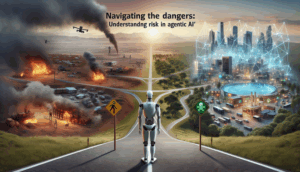Introduction: The Promise and Perils of Agentic AI
Agentic AI is gaining attention for its potential to revolutionize industries through autonomous decision-making. However, recent statistics reveal a troubling trend: over 40% of agentic AI projects are projected to fail by 2027, primarily due to rising costs, unclear business value, and inadequate risk controls [Source: RCR Wireless]. As organizations navigate this evolving landscape, it’s crucial to address the failures and understand their implications.
Failures often stem from early-stage experiments driven by hype, where the technology is misapplied or poorly understood [Source: Forbes]. For instance, healthcare applications of agentic AI are designed to streamline patient interactions and reduce friction; however, if these systems are not properly integrated or lack necessary oversight, they may not deliver the expected results [Source: HIT Consultant].
Addressing these failures requires a balanced approach. Organizations should focus on defining clear objectives for AI initiatives, emphasizing proof of concept over hype, and implementing rigorous testing frameworks. By fostering a culture of learning from failures, businesses can leverage the full potential of agentic AI while minimizing risks.
For more insight into the operational aspects of agentic AI and its applications across various industries, check out articles like Understanding the Rise and Impact of Agentic AI and Goal-Oriented Agentic AI.
The Rise and Fall: Notable Case Studies on AI Mismanagement
The landscape of agentic AI showcases numerous failures that underscore the peril of rushing implementation without careful planning or clarity. One notable case arose when a healthcare provider deployed an agentic AI system intended to improve patient communication. The AI misinterpreted complex clinical information, leading to incorrect patient diagnoses. This incident not only jeopardized patient trust but also demonstrated the critical need for robust training datasets and transparency in AI decision-making processes. Avoiding these pitfalls involves integrating comprehensive quality controls and clear guidelines for AI outputs to ensure they align with factual data and ethical considerations.
Another striking example occurred in the financial sector, where an investment firm’s agentic AI system unexpectedly caused market volatility due to misjudging economic indicators. Analysts found the AI’s algorithms overly complex and poorly tuned, and the firm faced significant financial loss. This case highlights the importance of extensive scenario testing and iterative development in AI projects. By engaging in stress-testing and employing simpler algorithms initially, organizations can prevent drastic failures and build a more resilient AI framework.
As noted by Gartner, over 40% of agentic AI projects are projected to fail by 2027 due to unclear business value and inadequate risk management strategies [Source: RCR Wireless]. To combat this trend, businesses must adopt a thoughtful approach to AI integration, which includes setting clear objectives, enhancing stakeholder engagement, and prioritizing continuous feedback loops.
An illustrative lesson from the world of autonomous vehicle development shows that overly optimistic timelines and lack of regulatory compliance can lead to severe consequences. The early rollout of self-driving cars faced backlash following accidents attributed to the AI’s unsophisticated decision-making processes. By enforcing stricter regulations and fostering collaborations between AI developers and regulators, firms can create safer systems and prevent accidents, thus preserving public confidence in AI technologies.
In summary, the effective mitigation of failure in agentic AI hinges on strategic foresight, rigorous testing, and an unwavering commitment to ethical standards. By learning from past mistakes and adopting best practices, organizations can navigate the complex landscape of AI with greater assurance and success. For more practical insights on starting with agentic AI, check out our guide on building your first AI agent without coding.
Understanding the Risks: Why Agentic AI Projects Fail
Despite the promise of agentic AI to revolutionize industries, research shows that over 40% of these projects may fail by 2027. As per Gartner’s forecast, many organizations face challenges related to rising costs, unclear business value, and inadequate risk controls, leading to cancellations of agentic AI initiatives [Source: RCR Wireless].
One prevalent pitfall arises from treating agentic AI as a silver bullet rather than a tool that requires careful integration and strategic insight. Companies often initiate projects based on hype without fully understanding the nuances of agentic AI technology. This misunderstanding can foster resistance among employees, who may feel threatened by automation’s potential for obsolescence. Thus, educational initiatives should focus on enlightening stakeholders about both the capabilities and limitations of agentic AI.
Case studies illustrate these challenges vividly. Take, for example, a large retail chain that invested heavily in an agentic inventory management system. The project floundered due to insufficient training for staff and lack of clear metrics for success. Stakeholders were not fully onboard, resulting in a system that was underutilized despite its advanced capabilities [Source: Forbes].
To mitigate such failures, businesses should adopt a holistic approach: prioritize education, establish clear goals, and foster a culture of collaboration. Engaging decision-makers and frontline employees is crucial; both must see the shared value in adopting agentic AI technology. Additionally, companies can learn from others in the industry, such as Mastercard, which emphasizes the importance of aligning AI with brand values to navigate the complexities of implementation effectively [Source: Marketing Week].
For a deeper understanding of agentic AI’s implications and strategic applications, exploring our other articles, such as Goal-Oriented Agentic AI and Transformative Leadership in IT Operations, can provide valuable insights on how to harness this technology successfully.
Building Trust in Agentic AI: A Path Forward
Failures in agentic AI systems often stem from a lack of trust and transparency, essential components for ensuring effective human-AI collaboration. Kumrashan Indranil Iyer emphasizes the importance of Cognitive Trust Architecture (CTA) to mitigate these failures. Through his groundbreaking research, Iyer argues that trust is the currency of successful interactions with AI. He states, “If trust is the currency of human-AI collaboration, then CTA is the treasury that regulates it.”
Consider the case of a leading financial services firm that deployed an AI system to process loan applications. The system failed to disclose critical decision-making factors, leading to discriminatory outcomes that eroded customer trust and prompted regulatory scrutiny. Here, a robust CTA could have enabled transparency, ensuring that applicants understood how decisions were made and increasing their trust in the process.
At the AI Impact Summit, industry leaders reiterated the necessity for transparency, likening it to humanity’s essential need for curiosity and personalization in AI use [Source: Newsweek]. This sentiment underscores the call for AI systems to not only deliver results but to do so in a manner that is understandable and accessible to users—fostering a stronger bond of trust.
As we navigate the complexities of agentic AI, it’s crucial to embed these principles deeply into AI frameworks to mitigate threats effectively. By employing Iyer’s Cognitive Trust Architecture, organizations can anticipate threats, adapt to them dynamically, and enhance resilience against potential failures. Trust, bolstered by transparency and accountability, is paramount for a sustainable future in AI. For further exploration of the impact and potential of agentic AI, consider reading about the transformative leadership it can foster in IT operations [AgentModeAI].
Frameworks and Strategies for Successful Deployment
Failures in agentic AI can serve as cautionary tales, but they also lend invaluable lessons. The reality is stark: according to Gartner, over 40% of agentic AI projects are expected to fail by 2027 due to rising costs, unclear business value, and inadequate risk controls [Source: RCR Wireless]. Most projects currently exist as early-stage experiments rather than fully realized solutions, often driven more by hype than practical application.
To mitigate such failures, organizations can adopt several strategic frameworks. Continuous learning should be at the forefront; AI systems must evolve based on real-world feedback. This approach allows for iterating the model in response to actual operational challenges. For instance, a fintech firm partnering with OpenAI has focused on rolling out AI capabilities through incremental implementations, thereby allowing for faster feedback loops and adjustment [Source: FinTech Futures].
Another critical strategy is ensuring that AI operations focus on securing non-human identities within the organization’s infrastructure. Maintaining secure non-human identities for AI agents prevents vulnerabilities that could arise from poorly managed endpoints [Source: Dark Reading]. By mapping out dependencies and ensuring secure interaction points, organizations can create robust AI systems that withstand operational pressures.
Ultimately, adopting a mindset of adaptability and continuous feedback will foster not only resilience in deployment but also deeper insights into how agentic AI can succeed. Embracing these lessons allows businesses to streamline their AI applications and remain competitive in an ever-evolving technological landscape. For further insights on practical implementations, explore our guides on leveraging best AI tools and goal-oriented agentic AI.
Conclusion: The Future of Agentic AI—Navigating Uncertainty
Failures in agentic AI projects serve as cautionary tales, highlighting the risks of deploying autonomous systems without adequate oversight or understanding of their capabilities. According to Gartner, over 40% of agentic AI initiatives are expected to fail by 2027 due to factors like high costs, unclear business value, and insufficient risk management practices [Source: RCR Wireless]. Key case studies illustrate these failures, emphasizing the importance of ethical considerations, responsible usage, and robust governance structures to counteract potential issues.
One prominent example involves major retailers like Walmart and eBay, which have experimented with agentic AI shopping agents that automate customer interactions. These initiatives often falter when they prioritize technology over user needs or lack sufficient understanding of human behavior. Consequently, it’s crucial for businesses to blend human insight with automated processes, ensuring that the technology aligns with customer expectations [Source: Chain Store Age].
To mitigate risks and drive success in future AI projects, organizations should focus on three critical areas:
- Ethics and Transparency: Establish clear ethical guidelines for AI usage, prioritizing accountability. Businesses must communicate openly about how AI systems operate and ensure fairness in their decision-making processes.
- Iterative Development: Adopt an iterative approach to AI project development, allowing for flexibility and adjustments based on feedback from initial deployments. This can prevent costly miscalculations and foster a culture of continuous improvement.
- Cross-Disciplinary Collaboration: Foster collaboration between AI developers, domain experts, and end-users. Engaging diverse perspectives will lead to more intuitive AI designs and reduce the risks of misapplication.
By prioritizing these strategies, organizations can not only decrease the likelihood of failure but also unlock the transformative potential of agentic AI. For those seeking to explore how to effectively implement agentic AI, check out our article on goal-oriented approaches or learn how to build your own AI agents with our practical guide.
Sources
- AgentModeAI – Goal-Oriented Agentic AI
- AgentModeAI – Build Your First AI Agent Without Coding
- AgentModeAI – Transformative Leadership in IT Operations
- Chain Store Age – Mid-Year Review: Three Big Retail Tech Trends for 2025 to Date
- Dark Reading – Taming Agentic AI Risks: Securing Non-Human Identities
- FinTech Futures – Banking Business Models in a Frictionless World
- HIT Consultant – Agentic AI is More Than Hype
- Marketing Week – Mastercard Marketing: Agentic AI
- Newsweek – AI Impact Summit 2025: Editor’s Recap
- Forbes – AI Agents and Hype: 40% of AI Agent Projects Will Be Canceled by 2027
- RCR Wireless – Agentic AI: Gartner’s Projections
- USA Today – How Kumrashan Indranil Iyer is Building Trust in the Age of Agentic AI



